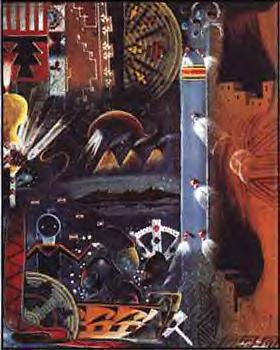|
|
Indian Youth Seek Bridge Between Tradition, Future
by Denise D. Tucker Argus
Leader
 FLANDREAU
-- An internal struggle simmers in many of today's American Indian youth.
FLANDREAU
-- An internal struggle simmers in many of today's American Indian youth.
It's a wracking pull between fulfilling their personal dreams and their sense of obligation to their reservations.
As South Dakota recognizes Native American Day, the children of the Indian culture find themselves at their own
personal crossroads.
They can see a future away from the reservation and its historic problems, yet they feel compelled to return and
make it a better place.
"I don't know if I should do what I want to do or what's best for my community," said Maria Quinonez,
a senior at the Flandreau Indian School.
"I want to go to college. I thought about going back to the reservation and helping out, but there aren't
a lot of opportunities there."
Flandreau Indian School is an off-reservation boarding high school operated by the Bureau of Indian Affairs. It
provides an education for students who have had limited educational opportunities.
A dream of being a teacher ultimately will lead Leona Tourtillott back to Keshena, Wis., where she is a member
of the Menominee tribe.
"I think I'll be successful when I'm a teacher," she said. "I've always wanted to teach, and I want
to teach my own people."
For the past three years, Tourtillott, 17, a senior at the Flandreau boarding school, has been participating in
a program called Anishinabe Teachers for Anishinabe Children.
"Indian schools normally hire Indian faculty when available," she said. "But there is a serious
shortage of Indian teachers. Many non-Indian teachers find it difficult to understand the Indian ways of life.
If they lack understanding, how can they teach in a way that nourishes the mental, emotional and spiritual needs
of our youth?"
Seniors Zeke Rodriguez, 18, and Noel Jose, 17, both want to help their tribes.
"I want to get into tribal law, to be an attorney," said Rodriguez of Black Water, Ariz.
He has been involved in the Close Up program, which teaches him about tribal law.
"It's important to learn about what's ours and how to protect it," said Rodriguez, who is a member of
the Pima tribe.
The Marine Corps and college are in the future for Jose before he returns to North Komelic, Ariz., where he is
a member of the Tohono O'Odham tribe.
"I want to work on the community," he said. "There are gangs and drunks at home. I want to get on
the tribal council and change things."
For 18-year-old Quinonez, the change must start with her, but that creates conflict.
"I want to explore -- do something different," she said. "I want to help people, but I want a better
job for myself. There are a lot more youths on my reservation that can help. I don't want to be stuck on the reservation."
Quinonez of Gila River, Ariz., is a member of the Pima tribe. And she wants a career that means something.
"I'm proud to be who I am," she said. "I don't want to be labeled as just an Indian without a job."
Living on a reservation isn't a curse, these students say.
"I have pride in my reservation," said Tourtillott. "Some people see it as a place to keep Indians
where they belong."
Jose hopes his home isn't destroyed by youths who are involved in gangs and drugs.
"Hopefully in a couple of years, I hope to see it stronger than what it is now," he said.
While their future might be outside the reservations, the students realize that others might not embrace them.
They say they are accustomed to encountering prejudice. They face it when they step off the boarding school grounds
and enter the non-Indian community.
It's most evident when they are followed around in some Flandreau shops or at shopping malls in other cities, Quinonez
said.
"They pretend that they are folding something or trying to fix something. But, they are always where you are,"
she said.
Tourtillott acknowledges that some of the school's students do steal, but she doesn't believe that all students
should be labeled thieves.
Poor treatment isn't limited to South Dakota.
"It's at home, too," Tourtillott said.
She attended a program at a college where some non-Indian students made war cries at her.
"It's real degrading," Tourtillott said.
Maintaining their Indian culture is important to the students. But they see it slipping away.
"Our traditions and language are almost completely gone," Quinonez said.
Tourtillott said her tribe also is losing its traditions. Only a few of the elders can speak their native language.
"Being Native American, you want to keep your traditions and cultures to stay strong," Quinonez said.![]()
|
|
| Canku Ota is a free Newsletter celebrating Native America, its traditions and accomplishments . We do not provide subscriber or visitor names to anyone. Some articles presented in Canku Ota may contain copyright material. We have received appropriate permissions for republishing any articles. Material appearing here is distributed without profit or monetary gain to those who have expressed an interest. This is in accordance with Title 17 U.S.C. section 107. |
|
Canku Ota is a copyright of Vicki Lockard and Paul Barry. |
|
The "Canku Ota - A Newsletter Celebrating Native America"
web site and its design is the Copyright © 1999 of Paul C. Barry. |